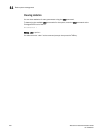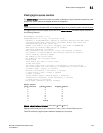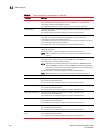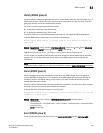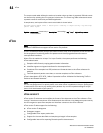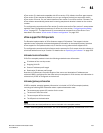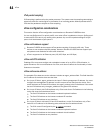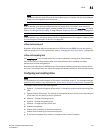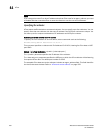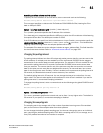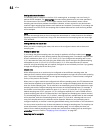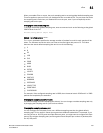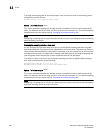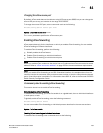
256 Brocade ICX 6650 Administration Guide
53-1002600-01
sFlow
11
IPv6 packet sampling
IPv6 sampling is performed by the packet processor. The system uses the sampling rate setting to
selectively mark the monitoring bit in the header of an incoming packet. Marked packets tell the
CPU that the packets are subject to sFlow sampling.
sFlow configuration considerations
This section lists the sFlow configuration considerations on Brocade ICX 6650 devices.
You can use QoS queue 1 for priority traffic, even when sFlow is enabled on the port. QoS queue 1
is reserved for sFlow and is not used by other packets. Any non-sFlow packets assigned to QoS
queue 1 will be directed to QoS queue 0.
sFlow and hardware support
• Brocade ICX 6650 devices support sFlow packet sampling of inbound traffic only. These
devices do not sample outbound packets. However, Brocade ICX 6650 devices support byte
and packet count statistics for both traffic directions.
• sFlow is supported on all Ethernet ports (10/100, Gbps, and 10 Gbps)
sFlow and CPU utilization
Enabling sFlow may cause a slight and noticeable increase of up to 20% in CPU utilization. In
typical scenarios, this is normal behavior for sFlow, and does not affect the functionality of other
features on the switch.
sFlow and source address
The sampled sFlow data sent to the collectors includes an agent_address field. This field identifies
the IP address of the device that sent the data:
• On a Layer 2 Switch, agent_address is the Layer 2 Switch management IP address. You must
configure the management IP address in order to export sFlow data from the device. If the
switch has both an IPv4 and IPv6 address, the agent_address is the IPv4 address. If the switch
has an IPv6 address only, the agent_address is the global IPv6 address.
• On a Layer 3 Switch with IPv6 interfaces only, sFlow looks for an IPv6 address in the following
order, and uses the first address found:
• The first IPv6 address on the lowest-numbered loopback interface
• The first IPv6 address on the lowest-numbered VE interface
• The first IPv6 address on any interface
• On a Layer 3 Switch with both IPv4 and IPv6 interfaces, or with IPv4 interfaces only, sFlow
looks for an IP address in the following order, and uses the first address found:
• The IPv4 router ID configured by the ip router-id command
• The first IPv4 address on the lowest-numbered loopback interface
• The first IPv4 address on the lowest-numbered virtual interface
• The first IPv4 address on any interface



